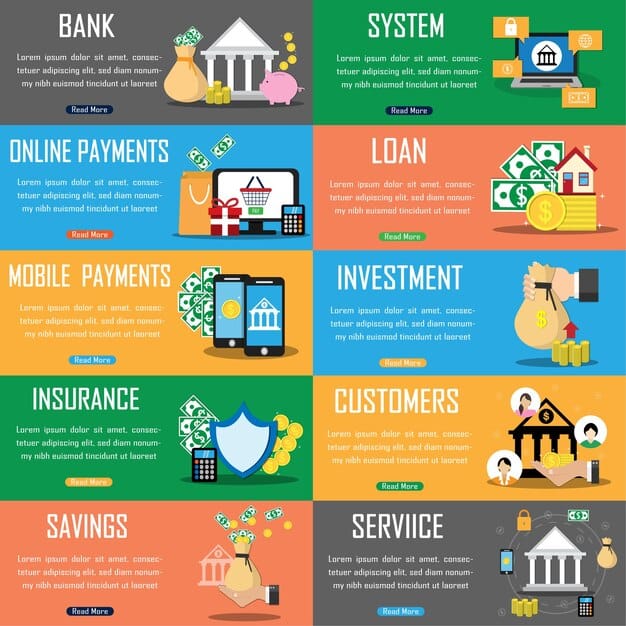Government Funding for Startups in US: A Comprehensive Guide

Navigating the landscape of government funding programs for startups in the US can unlock significant non-dilutive capital, offering a crucial lifeline for innovation and growth without equity surrender.
For many emerging businesses, securing sufficient capital is a perpetual challenge. While venture capital and angel investors often dominate headlines, a less-publicized yet equally vital source of non-dilutive funding exists: government funding programs for startups in the US. These initiatives, spanning federal, state, and local levels, can provide critical financial support, fostering research, development, and commercialization of innovative ideas, often without requiring equity in return.
The Spectrum of US Government Funding
Understanding the vast array of government funding options can be daunting for startup founders. From grants and loans to incubators and tax incentives, the US government utilizes various mechanisms to stimulate economic growth, support technological advancements, and address societal challenges. Each program has unique eligibility criteria, application processes, and objectives, catering to different stages of startup development and specific industry sectors.
Federal agencies, in particular, play a significant role in disbursing funds. Their initiatives are often broad in scope, aiming to drive national priorities such as scientific discovery, defense innovation, clean energy, or public health. State and local governments, conversely, might focus on regional economic development, job creation within their jurisdictions, or supporting industries unique to their locale. Navigating this landscape requires diligent research and a clear understanding of your startup’s long-term goals and alignment with government priorities.

The strategic pursuit of government funding is not merely about obtaining capital; it’s also about validating your business concept against rigorous review processes, gaining credibility, and potentially attracting private investment down the line. Many government programs are designed to de-risk ambitious ventures, making them more attractive to private investors once they demonstrate initial traction or meet specific milestones. This catalytic effect can be invaluable for early-stage companies.
Types of Government Funding
Government funding primarily falls into several distinct categories, each with its own characteristics and ideal use cases:
- Grants: Non-repayable funds awarded for specific projects, often tied to research and development.
- Loans: Capital that must be repaid, frequently with more favorable terms than commercial loans.
- Tax Incentives: Reductions in tax liability, encouraging certain activities like R&D or job creation.
- Direct Investments/Equity Programs: Less common, but some government entities make direct investments or participate in equity schemes.
Beyond direct financial aid, governmental support often extends to technical assistance, training, and access to networks. Incubators and accelerators supported by government entities provide resources like office space, mentorship, and business development guidance. These non-monetary benefits can be as crucial as direct funding, particularly for nascent companies learning to navigate the complexities of entrepreneurship and scalability.
Understanding the Non-Dilutive Advantage
One of the most compelling aspects of government funding, especially grants, is its non-dilutive nature. Unlike equity investments from venture capitalists or angel investors, non-dilutive funding does not require founders to give up ownership or control of their company. This preserves the equity stakes of early founders and employees, allowing them to reap more significant rewards if the company succeeds. It also means less pressure from external investors regarding immediate returns, offering more breathing room for long-term strategic development and risk-taking essential for true innovation.
This characteristic makes government funding particularly attractive for companies with demanding R&D cycles or those operating in sectors with long commercialization timelines. Biotechnology, advanced manufacturing, and deep tech startups often find government grants to be a perfect fit, enabling them to pursue groundbreaking research without the constant pressure of short-term profitability that often accompanies private investment. It’s a strategic capital source that prioritizes innovation over immediate financial returns, fostering a more sustainable growth trajectory for certain types of startups.
In essence, exploring the spectrum of US government funding is a strategic imperative for any startup seeking to grow sustainably, particularly those with a focus on innovation and solving complex problems. It requires a detailed understanding of the programs available and a clear articulation of how your venture aligns with national and regional objectives.
Key Federal Funding Programs for Startups
The federal government is a significant source of funding for startups, especially those involved in research and development. Two of the most prominent programs are the Small Business Innovation Research (SBIR) and Small Business Technology Transfer (STTR) programs, often referred to as “America’s Seed Fund.” These competitive programs encourage small businesses to engage in federal R&D that has the potential for commercialization.
The SBIR/STTR programs reserve a specific percentage of federal agency R&D budgets for small businesses. There are 11 federal agencies that participate in SBIR, and 5 of those also participate in STTR. Each agency has unique mission-specific solicitations, meaning startups need to align their proposed projects with the agency’s research priorities. This typically involves a multi-phase process, starting with a feasibility study (Phase I) and progressing to full R&D (Phase II), with a path toward commercialization (Phase III).
Beyond SBIR/STTR, numerous other federal agencies offer specialized grants relevant to specific industries. For instance, the Department of Energy (DOE) supports clean energy technologies, while the National Institutes of Health (NIH) funds health and medical research. The National Science Foundation (NSF) often supports fundamental research with commercial potential across various scientific and engineering disciplines. Founders must meticulously research agency solicitations to identify opportunities that perfectly match their innovation and business model.
The SBIR/STTR Advantage
The primary advantage of SBIR/STTR funding is that it’s non-dilutive, meaning startups retain full ownership of their intellectual property without giving up equity. This is a critical factor for founders who wish to maintain control and maximize future returns. Moreover, winning an SBIR/STTR award signals a strong endorsement from a federal agency, often making it easier to attract follow-on private investment.
- Non-Dilutive Capital: No equity is surrendered for funding.
- Validation and Credibility: Federal award acts as a significant stamp of approval.
- Intellectual Property Retention: Startups retain full rights to their innovations.
- Bridge to Commercialization: Provides structured funding from R&D to market readiness.
The application process for SBIR/STTR can be rigorous, requiring detailed technical proposals and a clear commercialization plan. However, the potential returns—both financial and in terms of credibility—make it highly worthwhile for eligible science and technology-driven startups. Many states also offer matching funds or support programs to complement federal SBIR/STTR awards, further enhancing their value.
Other Federal Agency Programs
Individual federal agencies also manage their own grant and loan programs targeting specific sectors or national objectives. For example, the Department of Defense (DoD) funds innovations critical for national security, ranging from advanced materials to cybersecurity. The USDA (US Department of Agriculture) supports agricultural innovation, rural development, and food security. Understanding the mission and funding priorities of each agency is key to successful application.
The Small Business Administration (SBA) offers various loan programs, though these are typically not direct loans from the government. Instead, the SBA guarantees a portion of loans made by commercial lenders, making it easier for traditional banks to lend to small businesses. Programs like the 7(a) Loan Program and the 504 Loan Program are widely used by small businesses to acquire real estate, equipment, or working capital. While these are loans and must be repaid, the government guarantee often results in more favorable terms and access to capital for businesses that might otherwise struggle to qualify for conventional financing.
For startups, the SBA also provides extensive resources beyond just financial programs, including counseling and training services through its network of Small Business Development Centers (SBDCs) and Women’s Business Centers (WBCs). These resources can be instrumental in helping startups develop robust business plans, navigate regulatory requirements, and access entrepreneurship education crucial for long-term success. The breadth of federal support extends far beyond just direct funding, encompassing a multifaceted ecosystem designed to foster small business growth and innovation across the nation.
State and Local Government Initiatives
While federal programs like SBIR/STTR are significant, state and local governments also play a crucial role in fostering startup ecosystems through a variety of unique initiatives. These programs are often tailored to regional economic development goals, targeting specific industries or aiming to address local challenges. Understanding the unique landscape of your state and city can uncover bespoke funding opportunities not available at the federal level.
Many states offer their own grant programs, often focusing on technology commercialization, job creation, or supporting industries critical to the state’s economy. These can include innovation grants for early-stage companies, matching funds for federal SBIR/STTR awards, or programs that encourage collaboration between startups and local universities. Economic development agencies at the state level are typically the best resource for identifying these opportunities, as they are actively working to attract and retain businesses within their borders.
Local governments, such as city or county administrations, may also provide funding or incentives, though these are often smaller in scale compared to state or federal programs. Their focus might be on downtown revitalization, supporting small businesses in specific neighborhoods, or fostering local entrepreneurship through incubators and accelerators. These programs can be highly valuable for community-based startups or those looking to establish a strong local presence.
Targeted State Grant Programs
States often have specific grant programs for sectors they aim to promote. For instance, California might have grants for renewable energy or biotech, while Texas could focus on oil and gas technology or advanced manufacturing. These grants are often designed to fill specific funding gaps not addressed by federal programs or private investors, effectively de-risking early-stage innovation within strategic industries for the state.
- Innovation Grants: Direct funding for novel technologies or business models.
- Matching Funds: Supplementary awards for federal grant recipients.
- Incubator/Accelerator Partnerships: Funding for programs that nurture startups.
- Industry-Specific Incentives: Financial encouragement for growth in key sectors.
Beyond direct grants, states may offer significant tax credits for research and development activities, job creation, or investments in specific technologies. These tax incentives can substantially reduce a startup’s operational costs, freeing up capital for further innovation and growth. Some states also run venture funds or participate in co-investment programs, where the state invests alongside private venture capital, helping to catalyze private funding flows into local startups.
Local Economic Development Support
At the most granular level, local economic development offices are key players. They often provide assistance in navigating local regulations, connecting startups with local resources, and sometimes offering direct micro-loans or grants. Initiatives like local business improvement districts (BIDs) or economic development corporations (EDCs) can offer tailored support for businesses operating within their specific boundaries.

It’s also common for local governments to support business incubators and accelerators, either directly or through partnerships with universities and non-profits. These facilities offer shared workspaces, mentorship, and access to a community of entrepreneurs. While not direct financial injections, the resources and networking opportunities provided can be invaluable for early-stage companies. Furthermore, some cities and counties offer expedited permitting processes or provide support for businesses locating in designated innovation zones, aimed at fostering concentrated growth.
Securing state and local funding often hinges on demonstrating a clear benefit to the local economy, whether through job creation, innovation that attracts other businesses, or addressing a specific community need. Building relationships with local economic development leaders and understanding their strategic priorities is crucial for startups looking to tap into these regionally focused financial lifelines. These localized programs, though sometimes smaller in scale, can be particularly impactful for businesses deeply embedded within a specific community or leveraging local resources.
Application Process and Best Practices
Securing government funding, regardless of the level, is a highly competitive process that demands meticulous preparation and a strategic approach. While the specific requirements vary widely depending on the program, some best practices apply almost universally. Founders who approach the application process with diligence and a clear understanding of the funder’s objectives significantly increase their chances of success.
The first critical step is thorough research. Identify programs that align not just with your funding needs but also with your startup’s mission, technology, and stage of development. Many government programs are highly specialized, and applying to those outside your core focus will likely be a waste of time and resources. Utilize official government portals like Grants.gov for federal opportunities, and explore state economic development websites for local programs.
Once a suitable program is identified, devote ample time to understanding its specific guidelines, eligibility criteria, and review process. Government applications are often extensive, requiring detailed technical proposals, comprehensive business plans, and strong commercialization strategies. A common pitfall is underestimating the time and effort required to craft a compelling application that addresses all aspects of the solicitation. Early preparation and a systematic approach are paramount.
Crafting a Winning Proposal
Your proposal is your opportunity to convince the funding agency that your startup is worthy of investment. It must clearly articulate the problem your solution addresses, the innovation you bring, the technical feasibility of your approach, and a robust plan for commercialization. Emphasize the potential impact—whether economic, societal, or technological—and how it aligns with the agency’s mission. Clarity, conciseness, and attention to detail are key.
A strong proposal typically includes:
- Technical Merit: Evidence of scientific or technological innovation and feasibility.
- Team Expertise: Highlight the qualifications and experience of your key personnel.
- Commercialization Plan: A clear strategy for bringing your innovation to market.
- Impact and Alignment: How your project benefits public interest and agency goals.
Additionally, demonstrating a strong understanding of the market, a clear financial model, and a pathway to sustainability beyond the grant funding are critical. Funders want to see that their investment will lead to a viable, successful enterprise. Seeking feedback on your proposal from mentors, consultants, or even previous grant recipients can provide invaluable insights and help refine your narrative.
Navigating the Submission and Review Process
Government applications often involve online portals, strict deadlines, and specific formatting requirements. Adhering to these precisely is non-negotiable. Missing a deadline or failing to follow formatting instructions can lead to immediate disqualification, regardless of the merit of your project. It’s advisable to start the submission process well in advance of the deadline to troubleshoot any technical issues that may arise.
The review process can be lengthy, often involving multiple stages of evaluation by experts in the field. These reviewers assess proposals based on criteria clearly outlined in the solicitation, which typically include technical merit, potential impact, and the qualifications of the applying team. Be prepared for potential requests for additional information or clarification during this phase. Patience is a virtue, as government funding cycles can take several months from submission to award notification.
Even if an application is not successful, the feedback provided by reviewers can be extremely valuable. It offers insights into weaknesses in your proposal or areas where your project might not have fully aligned with the agency’s priorities. This feedback can be used to refine future applications or even pivot aspects of your business strategy. Persistence is often a defining characteristic of successful grant applicants, as it’s common to apply multiple times before securing an award. Engaging with program officers, where permitted, can also offer valuable guidance on refining your approach and understanding funding trends.
Challenges and Considerations for Startups
While government funding offers significant advantages, startups must also be aware of the inherent challenges and unique considerations associated with these programs. Navigating the bureaucratic landscape, managing compliance requirements, and integrating government funds into a broader funding strategy all demand careful attention. A clear-eyed understanding of these aspects ensures that government funding truly becomes an asset rather than an unforeseen complication.
One of the primary challenges is the complexity and length of the application process. Government grants, particularly federal ones, require extensive documentation, detailed technical proposals, and often long lead times between application and award. This can be a significant drain on time and resources for lean startups already stretched thin. It often necessitates dedicated personnel or external consultants to manage the application process effectively.
Another consideration is the specific reporting and compliance requirements once funding is secured. Government awards come with strict regulations regarding accounting, progress reporting, and expenditure tracking. Non-compliance can lead to audits, repayment demands, or disqualification from future funding. Startups must be prepared to implement robust administrative systems to manage these obligations, which can be different from private sector reporting standards.
Navigating Bureaucracy and Timelines
The pace of government funding can be significantly slower than private investment cycles. From the announcement of a solicitation to the eventual disbursement of funds, the timeline can span many months, sometimes even over a year. For fast-moving startups operating in dynamic markets, this extended timeline requires careful financial planning to bridge potential funding gaps. Relying solely on a pending government grant without alternative financing can be risky.
- Extended Application Periods: Weeks to months for full application preparation.
- Lengthy Review Cycles: Can take several months for decisions.
- Disbursement Delays: Funds may not flow immediately after award.
- Detailed Reporting: Extensive administrative burden for milestones and financials.
Furthermore, the review process for government grants is typically opaque compared to private venture capital, where direct communication with investors is common. Feedback, if provided, might be generalized. This lack of direct dialogue can make it harder for startups to understand exactly why a proposal was unsuccessful or how to improve for the next cycle. Persistence and careful analysis of award criteria become even more important in this context.
Compliance and Financial Management
Government funding often comes with specific auditing and compliance requirements that differ from typical business accounting practices. For instance, adherence to specific cost principles, intellectual property rights originating from federally funded research, and procurement regulations can be complex. Startups may need to invest in specialized accounting software or seek expert advice to ensure they are fully compliant, avoiding potential penalties.
Managing intellectual property (IP) generated during federally funded research is another critical area. While SBIR/STTR programs generally allow small businesses to retain ownership of their IP, there are often specific government rights that must be understood and respected, such as “march-in rights” or requirements for US manufacturing in certain cases. Understanding these nuances from the outset is crucial for long-term IP strategy and commercialization planning.
Finally, government funding should ideally be part of a diversified funding strategy, not the sole source of capital. While non-dilutive funds are highly attractive, relying exclusively on them can limit a startup’s flexibility and potential for rapid scalability, especially if future private investment requires quick growth milestones. Strategic integration of government funds with private capital, and potentially revenue generation, offers the most robust path for sustainable growth. Startups that view government funding as a complementary rather than exclusive capital source are often better positioned for enduring success.
Integrating Government Funding into Your Startup Strategy
For startups, government funding should not be seen as a standalone solution but rather as a strategic component within a broader, diversified capital acquisition plan. Effectively integrating these funds can de-risk innovation, accelerate R&D, and enhance a startup’s attractiveness to private investors. The key lies in understanding how government programs can complement, rather than compete with, other funding sources.
At the early stages, non-dilutive grants can provide critical seed capital for proof-of-concept and prototype development, allowing founders to validate their technology without giving up equity prematurely. This enables them to reach significant milestones that would typically require angel or venture capital, thereby increasing their valuation and negotiating power for future private rounds. It’s about building a stronger foundation before seeking dilutive investment.
Later, as a startup matures, government loans can offer more favorable terms than traditional bank loans, particularly for capital expenditures or expansion. Tax incentives can reduce overall operational costs, freeing up cash flow for reinvestment in growth areas. The strategic orchestration of these various government resources, aligned with a clear business roadmap, defines a robust funding strategy.
Leveraging Grants for Early-Stage Validation
For deep tech and scientifically intensive startups, government grants act as an invaluable bridge between academic research and commercial viability. They allow for the exploration of high-risk, high-reward technologies that might be too speculative for traditional private investors. This early-stage validation, coupled with the credibility of a federal award, significantly de-risks the venture for subsequent private funding rounds.
Grants provide the runway to develop intellectual property, secure patents, and conduct rigorous testing. This accumulation of tangible assets and validated concepts increases a startup’s attractiveness to venture capitalists who typically seek validated technologies and measurable progress. Essentially, government grants enable startups to solve the “chicken-and-egg” problem of needing funding to prove their concept, but needing their concept proven to get funding.
Moreover, the rigorous application process itself can force founders to refine their business plans, articulate their value proposition more clearly, and forecast their commercialization path. This internal exercise, while demanding, strengthens the company’s strategic vision and prepares them for the scrutiny of private investors. The structured nature of federal scientific research awards often aligns well with iterative product development cycles.
Complementing Private Investment
Government funding doesn’t replace venture capital; it enhances it. Many VCs view a startup with government grants favorably, as it indicates external validation of the technology, often extends the startup’s cash runway, and reduces the amount of dilutive capital needed to achieve critical milestones. This can lead to more favorable terms for founders during equity financing rounds.
For example, an SBIR Phase II award, which can provide significant funding for R&D, allows a startup to allocate private venture capital towards market entry, sales, and scaling operations, rather than solely on early-stage technology development. This strategic allocation of funds optimizes the use of dilutive capital for maximum growth impact, accelerating speed to market.
Additionally, partnerships with government agencies or participation in government-supported incubators can open doors to new networks, potential customers, and critical technical expertise. These connections can be just as valuable as direct financial aid, providing a competitive edge in a crowded market. A startup that can demonstrate both strong government backing and private investor confidence sends a powerful signal of long-term viability and potential for significant returns. The blend of patient, non-dilutive government capital and agile, market-driven private investment creates a robust and sustainable funding strategy for innovative US startups.
Future Trends in Government Funding
The landscape of government funding programs for startups in the US is dynamic, constantly evolving to meet new economic challenges, technological advancements, and national priorities. Staying abreast of these emerging trends is crucial for startups looking to strategically position themselves for future funding opportunities. The emphasis is increasingly shifting towards specific sectors and collaborative models, reflecting a more targeted approach to economic development.
One significant trend is the increasing focus on critical and emerging technologies. The US government is heavily investing in areas such as artificial intelligence, quantum computing, advanced materials, biotechnology, cybersecurity, and clean energy. Programs dedicated to these sectors are expanding, often with larger allocations and more streamlined application processes. Startups operating in these cutting-edge fields will likely find a more receptive and abundant funding environment.
Another emerging trend is the emphasis on supply chain resilience and domestic manufacturing. Recent global events have highlighted vulnerabilities in critical supply chains, leading to government initiatives aimed at re-shoring production and fostering innovation in strategic industries within the US. Startups developing technologies that enhance domestic manufacturing capabilities or address supply chain vulnerabilities may find new avenues for government support.
Emphasis on Critical Technologies and National Security
Federal agencies, particularly those linked to defense and national security, are actively seeking innovative solutions from startups. This extends beyond traditional defense contractors to include commercial technologies with dual-use potential. Initiatives are being created to facilitate collaboration between startups and government agencies, accelerating the adoption of cutting-edge solutions for national challenges.
- AI & Machine Learning: Funding for applications across various sectors.
- Quantum Technologies: Support for research and commercialization.
- Biotechnology & Health Security: Continued investment in medical and public health innovations.
- Cybersecurity: Grants and contracts for advanced cyber defense solutions.
The concept of “innovation ecosystems” is also gaining traction, with government agencies supporting regional hubs that bring together startups, universities, corporations, and investors. These ecosystems aim to accelerate innovation and commercialization by fostering collaboration and providing shared resources. Startups that actively participate in or align with these regional hubs may find enhanced funding opportunities and expedited access to critical support networks.
Sustainable and Inclusive Growth Initiatives
Beyond technology, there’s a growing governmental emphasis on sustainable development and inclusive growth. This translates into programs supporting climate tech, renewable energy solutions, and initiatives that promote entrepreneurship among underrepresented groups. The focus is not just on economic output but also on creating a more equitable and environmentally responsible economy.
For example, programs promoting rural development, small business growth in underserved communities, or sustainable agricultural practices are likely to see continued investment. Startups with a clear social impact component, or those contributing to environmental sustainability, may find tailored funding opportunities that align with broader governmental objectives for an inclusive and resilient economy. This shift reflects a recognition that innovation must serve not only technological advancement but also societal well-being and environmental stewardship.
Finally, there is an ongoing effort to simplify and streamline the application processes for government funding. While still complex, agencies are increasingly adopting digital platforms and providing more comprehensive guidance to make programs more accessible, especially for first-time applicants. Monitoring these reforms and leveraging available resources can significantly ease the burden of applying. By understanding these future trends, startups can proactively adjust their strategies, ensuring they are well-positioned to access the evolving array of government funding opportunities in the US.
| Key Point | Brief Description |
|---|---|
| 🚀 Non-Dilutive Capital | Many government grants offer funding without requiring equity or company ownership. |
| 🏛️ Federal Programs | SBIR/STTR are key for R&D. Agencies like NIH, NSF, and DoD offer specific grants. |
| 🗺️ State & Local Help | Regional grants, tax incentives, and incubators target specific local economic goals. |
| 📊 Application Strategy | Thorough research, detailed proposals, and clear commercialization plans are vital. |
Frequently Asked Questions About Government Funding for Startups
Non-dilutive funding means capital received without giving up equity or ownership in your company. It’s crucial for startups because it allows founders to maintain control and maximize their stake while still accessing essential funds for research, development, or operational growth.
The primary programs are the Small Business Innovation Research (SBIR) and Small Business Technology Transfer (STTR) programs. These initiatives provide grants for R&D with a strong potential for commercialization, distributed by 11 federal agencies across various scientific and technical fields.
State and local programs are often tailored to specific regional economic development goals, focusing on local industries, job creation, or community revitalization. They can include grants, tax incentives, or support for local incubators, complementing broader federal initiatives with regional focus.
Challenges include lengthy and complex application processes, strict compliance and reporting requirements post-award, and extended timelines from application to fund disbursement. Startups need significant patience and robust administrative systems to navigate these aspects successfully.
Government funding, especially grants, provides non-dilutive capital that de-risks early-stage R&D. A federal award acts as a strong validation of the technology and team, extending the cash runway and allowing private investment to be used more efficiently for scaling and market entry.
Conclusion: A Strategic Imperative for US Startups
Navigating the complex, yet highly rewarding, landscape of government funding programs for startups in the US presents a strategic imperative for entrepreneurs. From the significant non-dilutive capital offered by federal grants like SBIR/STTR to the targeted support from state and local initiatives, these programs offer crucial lifelines that can de-risk innovation, accelerate development, and provide a strong foundation for future growth. While the application process demands meticulous preparation and patience, the benefits—including intellectual property retention, enhanced credibility, and the ability to focus on long-term R&D—far outweigh the challenges. Successfully integrating government funding into a diversified capital strategy positions startups for sustainable success, enabling them to bring groundbreaking innovations to market that benefit both their bottom line and broader societal goals. For any forward-thinking US startup, understanding and pursuing these opportunities is not just an option, but a critical component of a winning long-term strategy.





